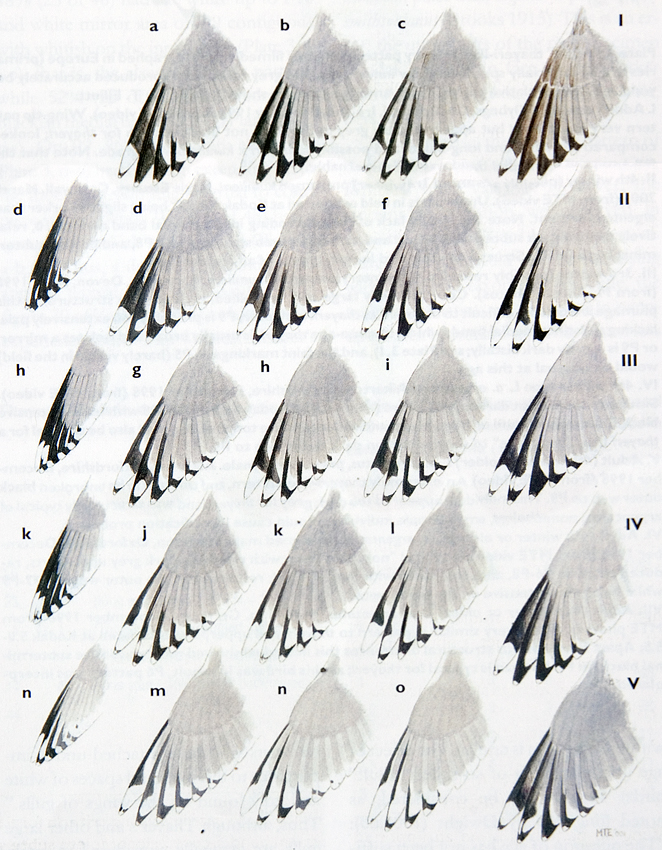 Thayer's Gull (thayeri)
Thayer's Gull (thayeri)
(last update: January 22, 2013)
Thayer's Gull - Plate 3.
From: Identification and Variation of Winter Adult Thayer’s Gulls with Comments on Taxonomy, by Steve N.G. Howell & Martin T. Elliott, IN: Alula 4/2001.
Plate 3. "Adult" primary patterns of presumed Thayer's Gulls Larus thayeri (a-o, I) and selected Nearctic congeners (II-V). Main figures show wings spread more fully than usually seen in the field, in order to show the inner webs; four left-hand figures show selected patterns of half-closed wings (not to scale). All wing-tip patterns from video or photographic material taken in Marin County, California, December I999 (except II, from Newfoundland, February 2000; courtesy P. Doherty/Bird Images).
© Martin T. Elliott.
Figures a-o (with possible exception of b), show birds judged to be at least in their 4th winter. Sub-sets of three are arranged in rows to show possible development of primary pattern types with advancing age. Figures a-l depict probable normal range of "typical" adult thayeri; intermediate patterns occurred and can be inferred from the patterns shown (see Table 1 for relative frequency of each pattern). Note that no birds showed extensive black on P9 in conjunction with classic thayeri pattem on P10; that extent of dark on outer webs of P8 and P9 is presumed to be affected by age; and that melanism on P5 and P6 appears unreliable as a sole character for ageing.
a-c. Presumed "young adult" thayeri, indicated by extensive primary melanism, e.g., on P9 and outer webs of P8, and (in the case of b) other plumage and bare-part features. All presumed < 5th winter (with b possibly an advanced 3rd winter).
d-f. Adult thayeri (> 4th winter) with continuously black outer webs to P9.
g-i. Adult thayeri (> 4th winter) with complete medial band to P10.
j-l. Presumed older adult thayeri (> Sth winter) with classic thayeri pattern on P9 and P10, melanism reduced on P5-P8.
m-o. Adult Larus sp. (> 4th winter) with reduced or paler primary melanism and/or paler upperparts than typical thayeri. These were the only three (of 120 3rd-winter or older birds) paler than deemed acceptable as pure thayeri; in addition, n and o were also "abnormally" small-billed, slender, and generally smaller than presumed female thayeri present, suggesting
introgression with kumlieni/glaucoides.
I. Example of 3rd-winter thayeri upperwing pattern. Note extensively dark outer webs to P7-P9 and diffuse, poorly-defined dark areas on inner webs of P9 and P10.
II. Adult L. a. smithsonianus with extreme thayeri-like wing-tip pattern; such birds are commonest in north-eastern North America (Macpherson 1961), rare in central California in winter (SNGH, pers. obs.) and are best separated from thayeri by size, structure, and bare-part colours.
III-IV. Examples of adult presumed L glaucescens x L a. smithsonianus hybrids. The full range of wing-tip patterns in this hybrid combination still needs to be established; many resemble thayeri and such birds are best identified by structural and bare-part characters.
V. Example of thayeri-like wing-tip pattern of adult presumed L glaucescens x L occidentalis
hybrid. Such birds are usually separated readily from thayeri by structural and bare-part characters, and frequently are darker above.
(click on plate for enlargement)
